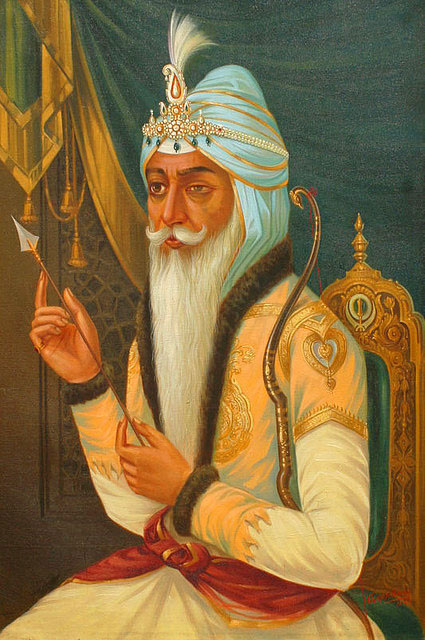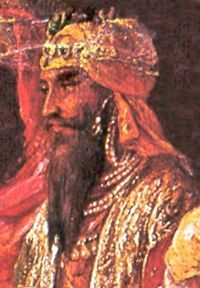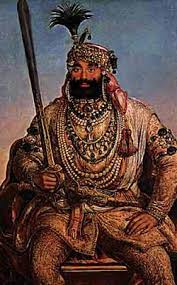Maharani Jind Kaur: “The Last Queen” of the Sikh Kingdom
Travelling to Punjab on a journey of soul-searching and meditation, religiously-inclined Bhupinder Singh from Houston embarked on a journey of the Sikh Empire reading celebrated author Chitra Banerjee Divakuaruni’s recently published historical novel –The Last Queen, based on the life of the Maharajan Jind Kaur, also known as Maharani Jindan. Bhupinder Singh presents a synopsis of the novel, which is a fascinating read about the life and struggles of Maharani Jind Kaur known as Jindan, the youngest and the last queen of Maharaja Ranjit Singh, the ruler of the Sikh Kingdom, known as the Sarkar, whose kingdom stretching almost to Kabul in the west and to Delhi on the east with the historical city of Lahore as the capital.
![Travelling to Punjab on a journey of soul-searching and meditation, religiously-inclined Bhupinder Singh from Houston embarked on a journey of the Sikh Empire reading celebrated author Chitra Banerjee Divakuaruni’s recently published historical novel –The Last Queen, based on the life of the Maharajan Jind Kaur, also known as Maharani Jindan. Bhupinder Singh presents a synopsis of the novel, which is a fascinating read about the life and struggles of Maharani Jind Kaur known as Jindan, the youngest and the last […]](https://www.theworldsikhnews.com/wp-content/uploads/2021/10/Maharani-Jinda-360x266.jpg)
IT IS TRAGIC THAT LITTLE IS WRITTEN ABOUT MAHARANI JIND KAUR in the books published in the Indian sub-continent and even lesser is known about her indomitable courage. This book -The Last Queen, is about the most formidable female of the nineteenth century and the narrative coming from a female author makes a much-needed welcome change to the literary landscape. Interestingly the book is written as Jindan narrating her story in the first person. It is an interesting read.
This fast-paced and deeply engaging novel dwells upon the human personality of Jindan, who with her dint of tenacity faces the challenges of life. Her grit, fearlessness, and indomitable strong will, made the British attempt to swallow the last independent kingdom in India so formidable that all kinds of character assassination were resorted to by them to achieve their aim. The book is fast-paced and a recommended interesting read.
The author has divided the book into four sections -Girl, Bride, Queen, and Rebel. Each section captures a significant phase in her life. A beautiful daughter of the royal kennel keeper Manna Singh Aulakh rises from an impoverished childhood to become the youngest, trusted, and the favourite queen of Maharaja Ranjit Singh.

The first chapter titled Guavas captures the simple adventure of a hungry little village girl with her older brother Jawahar, who is determined to leave behind her impoverished childhood. We are introduced right in the beginning to her tenacity and strong willpower, an unrelenting quality that defined her character.
The second chapter titled Manna about her father, shares her feelings of resentment for him, for not being present in their lives and how she “can’t think of him as Father”. It gives a strange feeling that in the book Jindan refers to him as Manna and not as a father, on the other hand, while referring to her mother she employs the reverent and endearing term of “Biji”.
In the next chapter Lahore, the author captures the excitement of an awestruck “village pumpkin” from her maiden “bone-rattling travel” to Lahore, in a bullock cart squeezed amongst the baskets of jackfruits.
The last chapter of the first section titled Gurdwara details how she captures the heart of the most powerful ruler, almost 40 years older as he declares “Standing here in the Gurdwara Dehra Sahib, I Ranjit Singh will marry you – If I’m still alive”.
 The first chapter in the second section Bride is Sword describes in detail how Jindan is married to the sword of Maharaja Ranjit Singh, as he could not be physically present for his own wedding. The portrayal of the wedding ceremony in the words of Jindan is “The sword is heavy, but I carry it proudly around the holy book while the ragi sings the Lavan”.
The first chapter in the second section Bride is Sword describes in detail how Jindan is married to the sword of Maharaja Ranjit Singh, as he could not be physically present for his own wedding. The portrayal of the wedding ceremony in the words of Jindan is “The sword is heavy, but I carry it proudly around the holy book while the ragi sings the Lavan”.
The chapter Zenana poignantly captures the cold reception that she received from other wives and how the first dinner was a covered dish set on top of the chest and the old woman whispering in her ears “Maybe you shouldn’t eat the food”. Jindan’s feelings of being imprisoned in the royal palace are hauntingly covered.
Suddenly, she finds herself in the midst of rivalries from other queens in the Zenana. In the next chapter, Sheesh Mahal describes Jindan’s intimate feeling of being the bride in the gentle embrace of her husband, the most powerful king of “this entire land”.
The other chapters cover the facets of royal life and how Jindan is catapulted to become “Sarkar’s favourite queen”.

The Royal Game shares the promise the Maharaja made to Jindan that “you will be my last: The one who has filled my heart totally.” as well as the news of her pregnancy. The next chapter Birth covers the happiest day of Jindan’s life with the birth of her son named Dalip Singh.
The chapter Decision paints the picture of the tragic demise of the most powerful man and her husband, casting its gloom on Jindan and the infant Dalip. At minister Dhian Singh’’s instructions, she along with her son are directed to move to Jammu for their own safety.
The third section Queen dwells on Jindan’s troubles after she lost her husband with the total disarray in the kingdom built by her late husband, the visionary king. The tragic death of the heir Kharak, Ranjit’s eldest son due to health deterioration casts its first pale on the kingdom. Naunihal, Kharak son’s succession is short-lived as while returning from the Kharak’s funeral a portion of Roshni Darwaza collapsed on him killing him. These tumultuous events were taking place in Lahore and a note from Dhian Singh arrived in Jammu directing Jindan “you must bring Prince Dalip back to Lahore at once.”
 After a short stay in Lahore, soon we find Jindan living in Amritsar in the chapter with the same title. More intrigue and bloodshed with Ranjit’s son Sher Singh, Sher’s son Partap, Dhian dead and his wife Pathani throwing herself in his funeral pyre thus becoming Sati. Even the Sandhawalias – Ajit and Lehna were captured in a revenge killing and their heads severed.
After a short stay in Lahore, soon we find Jindan living in Amritsar in the chapter with the same title. More intrigue and bloodshed with Ranjit’s son Sher Singh, Sher’s son Partap, Dhian dead and his wife Pathani throwing herself in his funeral pyre thus becoming Sati. Even the Sandhawalias – Ajit and Lehna were captured in a revenge killing and their heads severed.
 Two days after the funeral, Jindan and Dalip at age 6 are moved to Sheesh Mahal, and Dalip was declared as the King with Hira becoming Wazir. Rani Jindan was appointed as the Regent to the child king. Although fearless, and defiant of conventional norms, she tried to establish herself as the power behind the throne. Looking for allies, her eyes fall on Lal Singh, with her desires overtaking her, cascading her into a dangerous liaison with him. Then Jindan finds herself losing her standing in the durbar, which she had fought very hard for. Still, she even tears herself away from her crying only child of 8 to be with her amour. In a final desperate act, Jindan unveils her pox-marked face to the courtiers to establish her fidelity to her kingdom.
Two days after the funeral, Jindan and Dalip at age 6 are moved to Sheesh Mahal, and Dalip was declared as the King with Hira becoming Wazir. Rani Jindan was appointed as the Regent to the child king. Although fearless, and defiant of conventional norms, she tried to establish herself as the power behind the throne. Looking for allies, her eyes fall on Lal Singh, with her desires overtaking her, cascading her into a dangerous liaison with him. Then Jindan finds herself losing her standing in the durbar, which she had fought very hard for. Still, she even tears herself away from her crying only child of 8 to be with her amour. In a final desperate act, Jindan unveils her pox-marked face to the courtiers to establish her fidelity to her kingdom.
The British in their efforts to malign Jindan labelled her “Messalina of Punjab” and started spreading the rumours.
She again puts the unveiling of the face to effective use with the Khalsa army by wooing them to her side with these words; “I’m entrusting you with my honour. Why then should I hide my face from you?” Soon the Khalsa army was on the hot chase of Hira and Jalla, who escaped towards Jammu with cartloads of state treasures. They were caught before they could reach Jammu and quickly put to death by the army.
The British in their efforts to malign Jindan labelled her “Messalina of Punjab” and started spreading the rumours.
“I am Rani Jindan. mother of Maharaja Dalip Singh, Mother of the Khalsa, That is my identity and my fate. “
The chapter Treachery makes for a painful reading as it shares details of betrayal of the army leadership –Jindan’s amour Lal, and even Tej who sold their allegiances to the British in hopes of rewards and jagirs. The treacherous Gulab becomes king of Jammu and Kashmir while keeping all the wealth of Suchet which belonged to the Sikh Raj.
 More damaging news arrived from Governor-general Dalhousie to Jindan declaring that because of her harmful influence on her son Dalip, she will be separated from him. The ruse given by Dalhousie was Jindan has suffered “attacks of madness”. Jindan is further framed for plotting a rebellion and is banished to Chunar Fort in distant Benaras. Jindan feels in her heart that these are all attempts to break her spirit. Dalhousie proclaims Punjab belongs to the British, and Dalip ten years old signs away the kingdom, becoming a prisoner in his own palace. He is banished to England, far away from Punjab.
More damaging news arrived from Governor-general Dalhousie to Jindan declaring that because of her harmful influence on her son Dalip, she will be separated from him. The ruse given by Dalhousie was Jindan has suffered “attacks of madness”. Jindan is further framed for plotting a rebellion and is banished to Chunar Fort in distant Benaras. Jindan feels in her heart that these are all attempts to break her spirit. Dalhousie proclaims Punjab belongs to the British, and Dalip ten years old signs away the kingdom, becoming a prisoner in his own palace. He is banished to England, far away from Punjab.
A mother and a son’s meeting took place at Spence’s Hotel after a separation of fourteen years. Jindan is shocked to discover his cropped hair instead of the pagri that Sikh men wear over unshorn hair.
Remarkably, Jindan dressed as her own seamstress Maahi, makes a successful escape from Chunar fort and heads to Nepal on foot alone via Patna and seeks asylum there.
The fourth and final section titled Rebel (1860-1863) makes for sad reading. India’s war of Independence against the British raged all around, while Nepal’s ruler Jung Bahadur supported the British by sending his army to Awadh for use by the British Commander-in-chief Campbell.
Jindan had seen a spate of tragic news all these years, so suddenly when she received a letter in English from her only son Dalip, about the permission he received to visit India for tiger-hunting. She is elated. There is a spark of new hope in her dwindling eyesight, and she announces her plan to go to Calcutta to meet Dalip. Nepal’s king Jung Bahadur impresses her that if she leaves, she cannot be let back in Nepal.
A mother and a son’s meeting took place at Spence’s Hotel after a separation of fourteen years. Jindan is shocked to discover his cropped hair instead of the pagri that Sikh men wear over unshorn hair. The prince along with his mother decide to live a quiet life in India, but the British fear their presence in India and had other plans for them to return to England. In the meantime, the Sikh Regiment returning to the port of Calcutta from the China War finds out about Dalip presence there, and they come to pay their respects to the exiled Maharaja at the Spence’s hotel. However, this incident only serves to further unnerve the British, hastening the departure of both -mother and son to England.
Jindan’s remains were not allowed to be brought back to Punjab and placed next to her husband Maharaja Ranjit Singh. However, Dilip is allowed to cremate the remains at Nasik, Maharashtra.
The chapter titled England has a vivid description of how Jindan copes and adjusts in the strange new country for a village girl from Gujaranvalla while feeling “the fist of the British government tightening around me”. Her only joy is that she is reunited with his son and “growing closer” to him.
The book ends with the tragic end of Jindan’s life and how even her remains were not allowed to be brought back to Punjab and placed next to her husband Maharaja Ranjit Singh. However, Dilip is allowed to cremate the remains at Nasik, Maharashtra on the banks of river Godavari and return to England from Bombay.

One thought on “Maharani Jind Kaur: “The Last Queen” of the Sikh Kingdom”